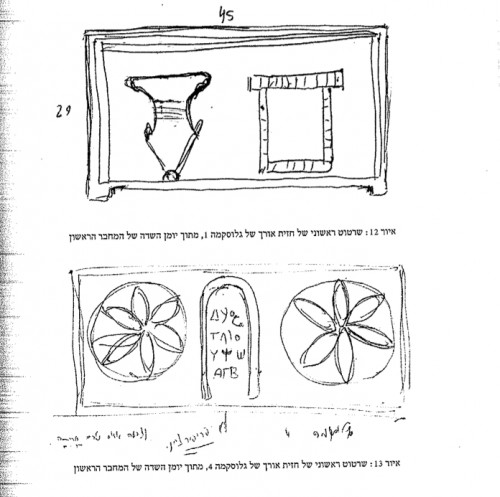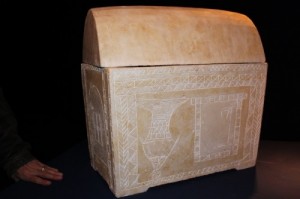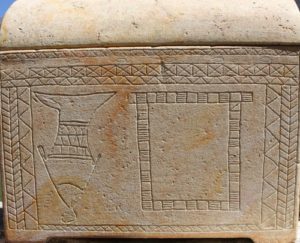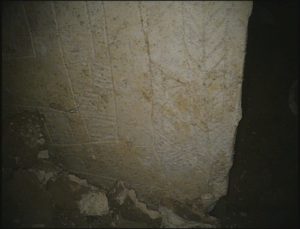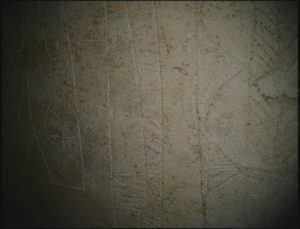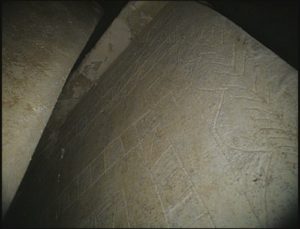Amos Kloner on the Talpiot “Patio” Tomb Finds: Some Troubling Questions
The following article was posted by James Tabor on jamestabor.com
Last week on this blog I noted a lecture that Prof. Amos Kloner gave at Bar Ilan University on December 27th at the “New Studies on Jerusalem Conference” on his original exploration of the Talpiot “Patio” tomb in 1981. Kloner’s intention was to “set the record straight” and more specifically, to counter what he considers to be the sloppy and sensational interpretations of Simcha Jacobovici and me, based on our 2010 re-examination of this sealed tomb by robotic camera. Archaeologist Rami Arav and I obtained an excavation license from the Israel Antiquities Authority to carry out this new investigation. This is the 1st century tomb less than 200 feet away from the alleged “Jesus family” tomb in East Talpiot in Jerusalem.
We have argued that one of the ossuaries in this tomb contains an image of a fish spouting out Jonah and a second has a four-line Greek inscription referring to “lifting up” or resurrection of the dead. We further maintain that both the inscription and the Jonah image most likely came from Jewish followers of Jesus who are affirming faith in resurrection of the dead. The main outlines of my argument I presented in a technical paper posted on-line at Bible & Interpretation here, as well as in a co-authored book that extensively deals with the evidence from both of the Talpiot tombs, The Jesus Discovery (Simon & Schuster, 2012). We have also released photos and other relevant documents related to our investigation at our official web site on the “Patio” tomb here. When the book and the article were published in February 2012, the American Schools of Oriental Research (ASOR) devoted the month of March to an open discussion of these finds and their interpretation on its blog, sparking a heated and controversial series of posts and comments with diverse points of view. The Israeli magazine Eretz made our discoveries and the resulting controversy a cover story of the May issue with the provoking article, “Who’s Afraid of the Tomb of Jesus?”
Prof. Kloner offered no input whatsoever to the month-long ASOR discussion so we now hear for the first time his views on the subject. He now reveals that he thinks the “Jonah” image is not a fish at all but a vase or “amphora,” and that the Greek inscription has nothing to do with resurrection but rather is a prohibition against disturbing bones. These various alternative interpretations, along with the idea that the “fish” is a “funerary tower,” were debated extensively on the ASOR blog and I have covered them extensively here on my blog though the month of March. I have read a transcript of his oral remarks, which I make available to readers here: Kloner Lecture Transcript. I have also obtained a copy of his much longer published paper on the subject in Hebrew, which can be ordered through the Rennert Center for Jerusalem Studies.
Kloner’s paper immediately generated an Op-Ed in the Times of Israel in which Matthew Kalman offered a very balanced overview here. I offered my own preliminary reactions here and Simcha Jacobovici, who was present at the lecture recorded his initial impressions which you can access here.
Late last night Simcha Jacobovici posted a long and probing piece based on his more carefully reading of Kloner’s published paper in Hebrew, which you can read here. Simcha and I have very different styles and I consider Amos Kloner a colleague and a friend, but the various problems he notes with Kloner’s account of the events of 1981 are serious and myriad. What jumped out at me when I read the full paper was that there is nothing Kloner reports seeing in 1981 that adds anything to our own camera probe discoveries in 2010, other than his reported “count” of how many individuals’ bones were in each ossuary–the basis of which one has to wonder. All the rest of the data were precisely what we reported.[1]
Most puzzling to me is the drawing Kloner publishes in his paper of the ossuary with the “Jonah and the fish” image. Kloner says that he made this sketch, along with another one of the ossuary with the Greek inscription, in 1981 while briefly inside the tomb. Why he had never revealed these before, not even to his co-author Shimon Gibson with whom he wrote his definitive paper on the Talpiot tombs for the forthcoming Charlesworth volume remains for him to answer.[2] The sketches are not in the Israel Antiquities Authority excavation files nor has anyone to my knowledge ever seen them before. We do know that the positions of these two ossuaries was different in 1981 from where they are today in the niches and the “Jonah” ossuary was not blocked from view in 1981 as it is today. So Kloner could have easily made such a sketch, or even better, taken a photo of both ossuaries.
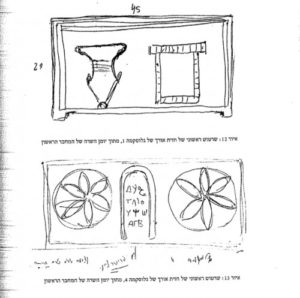
Here is the problem. We were not able to see the entire front of the ossuary with the Jonah image. That ossuary is blocked by the one with the Greek inscription right in front of it, butted up to a few centimeters against its face. You can see here our camera coming into the niche with these two ossuaries up against one another. The one in the back is the one with the “Jonah” image, and just enough of the left side of that ossuary was visible to us to make out the image and get fairly good photos. It was the right side of the ossuary that remained a mystery to us. Our camera caught the bare beginnings of the square “temple” like structure on the right side, but what was inside that structure that we could not see clearly. In his paper Kloner is quite interested in this structure and offers analysis as to its possible meanings–but without mentioning anything about its important internal features–which would surely reveal more as to what the artist was wanting to portray.
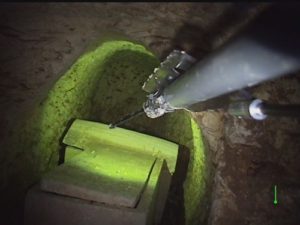
When we had our replicas made this became a real problem. Since we could not see clearly the right side of this ossuary how should it be presented? In our first attempt, which was the ossuary displayed in New York at our February 28th press conference, the artisan took our limited photos of the right side and could barely make out something inside the “temple” and tried to represent it partially. This caused no end of problems because what he ended up with looked like some kind of “hangman’s gallows.” This led to endless speculation on those who saw the reproduction as to what the mysterious hidden meaning of this marking might be. The truth is this was simply all we could make out with our camera shots and it would have been best to leave the space blank.
When we had a second set of ossuary reproductions made in Israel for our subsequent press conference in Jerusalem on April 4th we wanted to do whatever we could to improve our first attempt. We made the Jonah fish image a bit fatter, having reexamined all our photos, and most important Simcha and I advised Felix Gobulev who was working with the artisans to simply leave the inside of the temple-like structure blank. There was something substantial inside, but since we could not see what it was, why offer a partial sketch that could end up being misleading? Accordingly, the second reproduction looked like this:
When I saw Kloner’s drawing I almost fell off my chair. It was an almost precise copy of our Jerusalem ossuary reproduction. The only problem is, he also leaves the inside of the “temple” structure blank–just as we did, though it is clear that anyone who was looking at the full unblocked face of the ossuary would have seen what is obviously inside the “temple” like structure. The “blank” is not blank–there is a substantial architectural feature plainly visible. When I heard Kloner had presented his drawings I was quite excited. I was even wondering or hoping there might be some kind of inscription inside that “blank” space–and now we would know at last. I leave it to readers to draw their own conclusions and I welcome any explanation from Prof. Kloner.
In lieu of Kloner’s drawing, purportedly drawn in full view of the entire face of the ossuary, I publish here the only three photos we were able to obtain so that anyone interested might have a tiny “peek” at what lies inside the blank space. One in particular shows the beginnings of a substantial internal rectangular pattern, which became the basis for our “hangman’s gallows” in the original reproduction. These are the original untouched photos from our probe cameras and I realise they will appear somewhat dark here on this blog but those who wish to download them can easily lighten them up and sharpen the quality and you will be able to see quite a bit. We thought it best to present them here in their original state for anyone to work with who might be interested.
1. One example. Kloner had previously written in the publications below that there were “two Greek names” inscribed on ossuaries in this tomb. He says nothing about iconography or a Greek inscription, which presumably he not only saw but drew. We were able to see one name, MARA, but the other was out of range of our cameras. The only hint we had of this name was from the 1981 B&W photos, but it is faded and unclear, but at that time the ossuary was turned differently and plainly facing out. Kloner also reports that he can not read the second name, though anyone actually inside the tomb, looking right at the ossuary, would have seen the letters clearly. There are three published reports on the tomb, each tantalizingly sparse in details with some differences between them: Amos Kloner, Excavations and Surveys in Israel 1982, vol. 1, 78-81 (October 1982), p. 51; Amos Kloner, Survey of Jerusalem: the Southern Sector (Jerusalem: Israel Antiquities Authority, 2000), p. 84; Kloner and Zissu, Necropolis of Jerusalem, pp. 342, which contains a map by Kloner. The IAA files contain one single memo dated August 2, 1981 plus some photographs. An April 17, 1981 memo that Kloner wrote right after his team finished their work is referenced in the August 2nd memo but nowhere to be found. One early Roman period cooking pot was catalogued by the IAA as from this tomb, although excavators remember other items being removed. There is no copy of the excavation license. These are unfortunate losses and perhaps these and other materials will be recovered in the future. Curiously, Kloner reports that “three of the kokhim contained seven ossuaries” and does not mention removing an eighth one from a fourth niche, see Survey of Jerusalem: the Southern Sector (Jerusalem: Israel Antiquities Authority, 2000), p. 84. Kloner later published a sketch of the tomb showing the locations of all eight ossuaries, distributed in four of the niches, see See Necropolis of Jerusalem, pp. 342, published in 2007 with Boaz Zissu.
2. See Amos Kloner and Shimon Gibson, “The Talpiot tomb Reconsidered: The Archaeological Facts,” in The Tomb of Jesus and His Family? Exploring Ancient Jewish Tombs Near Jerusalem’s Walls: The Fourth Princeton Symposium on Judaism and Christian Origins, eds. James H. Charlesworth and Arthur C. Boulet (Grand Rapids: Eerdmans, forthcoming, 2013)
Click here for more articles by James Tabor.
